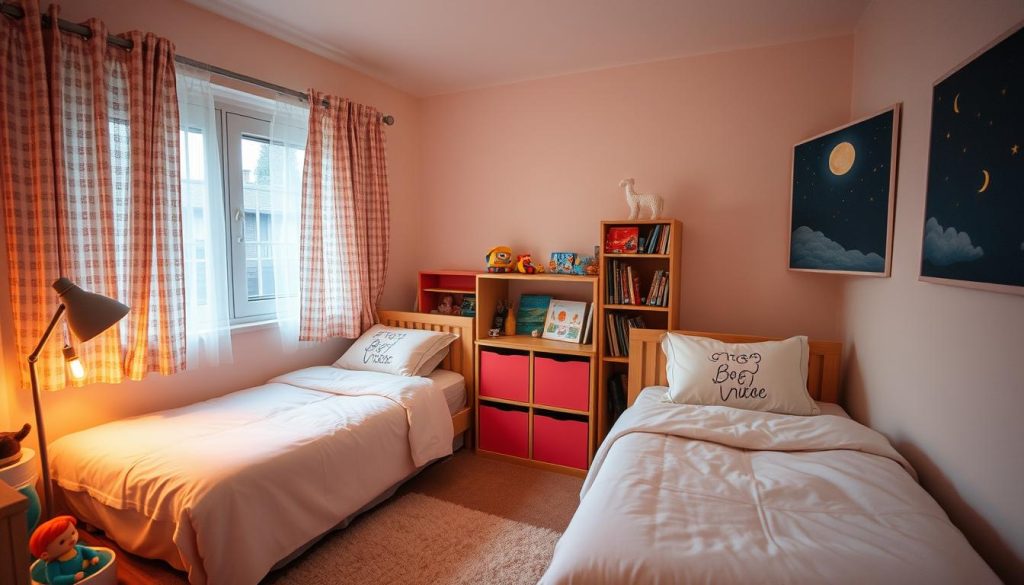Are you tired of nightly tantrums and restless kids when it’s time for bed? Sharing a room can make these challenges worse. But, is there a way to find peace without losing sleep?
Many families share rooms due to necessity or choice. It can help kids bond and learn about empathy and respect. Yet, bedtime often turns into a fight. Gentle parenting, clear talks about consent, and smart budgeting for the room can change this.
Start with a bedtime routine that works for both kids. Try staggering bedtimes so the sleepier one can rest first. Keep beds apart and use noise machines and shades for a quiet space. It’s also key to talk openly with your toddlers about what’s expected and the rules of sharing a room.
Key Takeaways
- Stagger bedtimes to cater to different sleep needs.
- Use noise machines and blackout shades to foster a calming sleep environment.
- Set clear, simple rules and communicate them transparently to your children.
- Rearrange beds to minimize disturbances, placing them as far apart as possible.
- Implement an ok-to-wake clock to help toddlers understand sleep and wake times.
- Childproof the room to ensure safety and peace of mind.
- Embrace the long-term benefits: siblings sharing a room fosters empathy, boundary setting, and stronger bonds.
Understanding the Challenges of Room Sharing
Sharing a room can be tough for kids and families. At first, everyone is excited, which can mess up sleep. This excitement might make bedtime talky or hard to settle down.
But, over time, sharing a room can make siblings close. This closeness can help them deal with family changes, like divorce. It can also lessen feelings of being a middle child and help with fighting between siblings.

The Initial Excitement and Its Impact
When kids start sharing a room, they’re often super excited. This excitement can make bedtime feel like playtime, making it hard to wind down. But, this phase is short-lived.
Soon, kids start to enjoy the bond they share. They learn to work together and appreciate each other’s company.
Common Issues During Bedtime
Bedtime can be tough when kids share a room. Different personalities, routines, and needs can cause problems. For instance, one might want quiet, while the other needs stories or sounds.
It’s important to be patient and find ways to compromise. This helps make bedtime routines smoother for everyone.
Long-Term Benefits of Siblings Sharing a Room
Despite the early hurdles, sharing a room has many benefits. It teaches kids to share and work together. These skills are key for getting along with siblings and adjusting to family changes.
Sharing a room also helps kids deal with divorce and middle child feelings. It teaches them to share and cooperate, reducing fights between siblings.
Effective Bedtime Routines for Shared Rooms
Having a consistent bedtime routine is key for a good night’s sleep in a shared room. It helps with different needs, like talking to kids about puberty or keeping them safe from social media. It also helps with coaching children’s sports.
Creating a Unified Bedtime Routine
Getting all kids involved in bedtime is important. Whether it’s reading to a 3-year-old or helping the oldest, a clear routine is crucial. Kids under 6 should sleep by 8 pm to stay well-rested.
Staggered Bedtimes: Pros and Cons
Staggered bedtimes work well for families with kids of different ages. Older kids get more time, while younger ones sleep earlier. This way, each child gets special attention, like in coaching children’s sports.
But, it can be hard to manage. You need to plan well to help each child sleep smoothly.
Implementing Wind-Down Time
Wind-down time is vital for a good night’s sleep. Activities like reading or quiet play help kids relax. A 20-minute wind-down before bed can really help.
Experts say no screens an hour before bed for better sleep. Getting everyone to agree on bedtime rules helps avoid arguments. These tips help parents manage the “witching hours” and make evenings peaceful.
Practical Tips for Minimizing Disturbances
Creating a sleep-friendly environment is key when kids share a room. It’s important to manage kids screen time well. Too much screen time can disrupt sleep and cause bedtime issues. A no-screen rule an hour before bed helps create a calm night.
It’s also crucial to address childhood eating disorders. Irregular eating can disturb sleep, affecting health and mood. Balanced meals and snacks at the right times help stabilize sleep. If a child wakes up hungry or uncomfortable, their diet might need adjusting.
Helping kids with anxiety at bedtime is also important. Bedtime can make kids anxious, leading to trouble sleeping. A consistent bedtime routine with calming activities like reading or music can help. Tools like sound machines and blackout curtains also improve sleep.

Setting a “no toys in bed” rule helps keep kids focused on sleep. Clear quiet time rules also promote a peaceful night. Parental involvement and setting a good example greatly influence kids’ behavior. This leads to a calm and restful shared room.
Parenting Challenges: Successfully Managing Sibling Dynamics
One big challenge for parents is making sure siblings get along. This is especially true when it comes to sleep. Setting and following sleep rules is key to keeping peace and making sure everyone sleeps well. Parents can use online family therapy and other strategies to handle conflicts and rivalry.

Establishing and Enforcing Sleep Rules
Clear sleep rules are important for setting boundaries. They help kids know what’s expected of them. It’s good to let kids help make these rules so they feel responsible.
Using Positive Reinforcement and Sticker Charts
Positive parenting works well, especially with rewards. Sticker charts are a great way to motivate kids. When they follow bedtime rules or are kind to their sibling, they get stickers. These can lead to bigger rewards.
Teaching Kids to Respect Each Other’s Sleep
Teaching respect and consent is crucial in a shared room. Start with lessons on personal space and thinking about others. Encourage kids to talk about quiet activities if they wake up early.
Role of Ok-to-Wake Clocks
Ok-to-Wake clocks help kids understand when it’s time to wake up. They give a clear signal, helping kids learn to stay in bed. This approach supports gentle parenting by teaching kids to be independent and quiet during sleep.
Adapting to the Transition and Setting Realistic Expectations
Changing your kids to share a room needs patience and realistic hopes. This change takes time for everyone. Knowing kids might act out, like throwing tantrums or being aggressive, helps you prepare and handle it well.

Gradual Adjustments and Patience
Start with small steps. Begin by having siblings spend short times in the shared room before bed. This helps them get used to the new space slowly. Use gentle parenting to make the transition smoother, focusing on talking and understanding each other.
It’s also key to focus on body positivity for kids. Make the sleep area comfy and respectful of each child’s space. Using eco-friendly items, like natural bedding, can also make the room feel calm.
Handling Setbacks and Maintaining Consistency
Setbacks happen. Kids, especially those with less social and emotional skills, might find it hard to adjust. Keeping bedtime routines and rules the same is very important. Use visual schedules or clear signals, as suggested by Artman-Meeker and Kinder, to help kids know what to expect.
Parents should also take care of their postpartum mental health. Being mentally strong helps you handle any problems better and shows your kids how to stay calm.
End by using gentle parenting methods. Focus on positive interactions and emotional safety. With time, kids will get used to their new sleeping setup, making bedtime peaceful for everyone.
Conclusion
Dealing with bedtime battles in shared rooms needs a mix of good communication, planning, and consistent parenting. Harmonizing bedtime routines helps create a calm space for sleep. Also, staggered bedtimes meet each child’s unique needs.
Family involvement is crucial, as shown by the U.S. Department of Health and Human Services and U.S. Department of Education. They stress the importance of family participation.
Using eco-friendly products can also improve sleep. Natural bedding and energy-saving night lights make the room peaceful. Studies show that supportive parenting helps kids manage their emotions better.
Talking about drugs and other important topics at bedtime is helpful. It builds trust and understanding between parents and kids. Budgeting well helps buy tools like ok-to-wake clocks and white noise machines. These tools reduce disturbances in shared rooms.
In summary, with these strategies, parents can manage shared bedtime challenges. They ensure a peaceful and harmonious home for their kids.
FAQ
What are the common parenting challenges when kids share a room?
How can I establish a consistent bedtime routine for kids sharing a room?
What are the long-term benefits of siblings sharing a room?
How can I minimize disturbances in a shared bedroom?
What role does positive reinforcement play in managing sibling dynamics?
How can I teach my kids to respect each other’s sleep needs?
What steps can I take to ensure a smooth transition to room sharing?
How can I use eco-friendly parenting strategies to enhance the sleep environment?
This post contains affiliate links. If you click on a link and make a purchase, I may earn a small commission — at no extra cost to you. Thank you for supporting this blog and helping me keep the patterns free! Read the full Affiliate Disclosure & Transparency.
